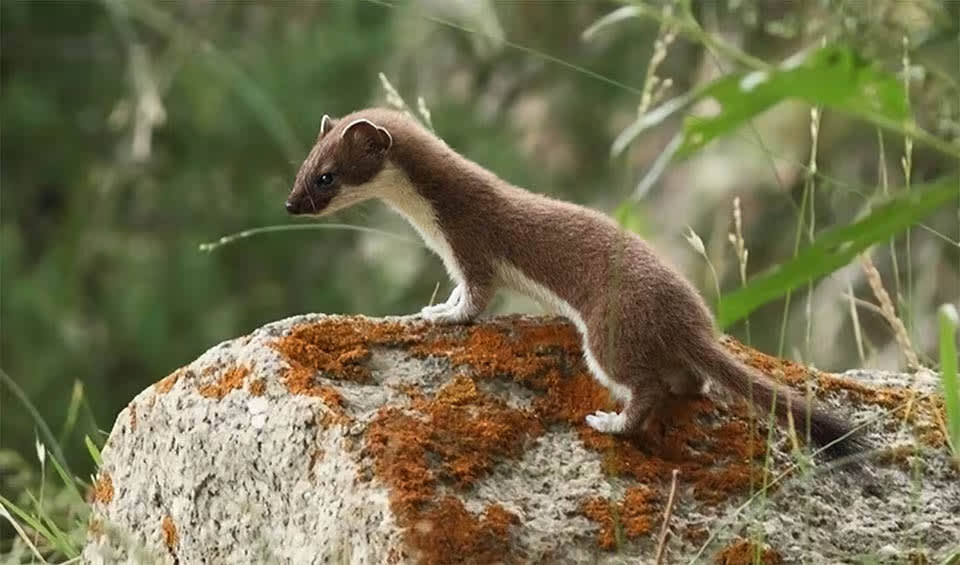Stoats, also known as short-tailed weasels, stand out as agile predators inhabiting a diverse range of ecosystems spanning the Northern Hemisphere. From grasslands to forests and even tundra regions, these adaptable creatures demonstrate remarkable versatility in their choice of habitats. Sporting slender bodies, long necks, and bushy tails, stoats possess distinctive physical features that aid in their hunting prowess and survival in varied environments.
A striking characteristic of stoats lies in their seasonal coat color changes, which serve both functional and aesthetic purposes. During the summer months, stoats exhibit a reddish-brown fur coat, providing camouflage amidst verdant foliage and sun-kissed landscapes. However, as winter descends and snow blankets the terrain, stoats undergo a remarkable transformation, donning a pristine white coat that blends seamlessly with the snowy backdrop. This adaptive coloration not only aids in camouflage but also helps regulate body temperature in cold climates.
Despite their diminutive size, stoats possess formidable hunting skills and a fearless attitude when it comes to pursuing prey. With keen senses and lightning-fast reflexes, they are adept at capturing prey species much larger than themselves. Stoats employ stealth and agility to stalk and ambush their quarry, relying on their sharp teeth and powerful jaws to deliver fatal bites to the neck or skull of their prey.
While stoats are not currently classified as threatened or endangered, certain subspecies, such as the New Zealand stoat, have posed significant challenges to native ecosystems. Introduced to non-native habitats, these invasive stoat populations have wreaked havoc on local biodiversity by preying on vulnerable native species.
Distribution
 Afghanistan
Afghanistan Albania
Albania Andorra
Andorra Austria
Austria Azerbaijan
Azerbaijan Belarus
Belarus Belgium
Belgium Bosnia And Herz.
Bosnia And Herz. Bulgaria
Bulgaria Canada
Canada China
China Croatia
Croatia Czechia
Czechia Denmark
Denmark Estonia
Estonia Finland
Finland France
France Georgia
Georgia Germany
Germany Greece
Greece Hungary
Hungary India
India Ireland
Ireland Italy
Italy Japan
Japan Kazakhstan
Kazakhstan Kyrgyzstan
Kyrgyzstan Latvia
Latvia Liechtenstein
Liechtenstein Lithuania
Lithuania Luxembourg
Luxembourg Moldova
Moldova Mongolia
Mongolia Montenegro
Montenegro Netherlands
Netherlands New Zealand
New Zealand North Macedonia
North Macedonia Norway
Norway Pakistan
Pakistan Poland
Poland Portugal
Portugal Romania
Romania Russia
Russia Serbia
Serbia Slovakia
Slovakia Slovenia
Slovenia Spain
Spain Sweden
Sweden Switzerland
Switzerland Tajikistan
Tajikistan Turkey
Turkey Ukraine
Ukraine United Kingdom
United Kingdom United States
United States Uzbekistan
UzbekistanAnything we've missed?
Help us improve this page by suggesting edits. Glory never dies!
Suggest an editGet to know me
Terrestrial / Aquatic
Altricial / Precocial
Polygamous / Monogamous
Dimorphic (size) / Monomorphic
Active: Diurnal / Nocturnal
Social behavior: Solitary / Pack / Herd
Diet: Carnivore / Herbivore / Omnivore / Piscivorous / Insectivore
Migratory: Yes / No
Domesticated: Yes / No
Dangerous: Yes / No





